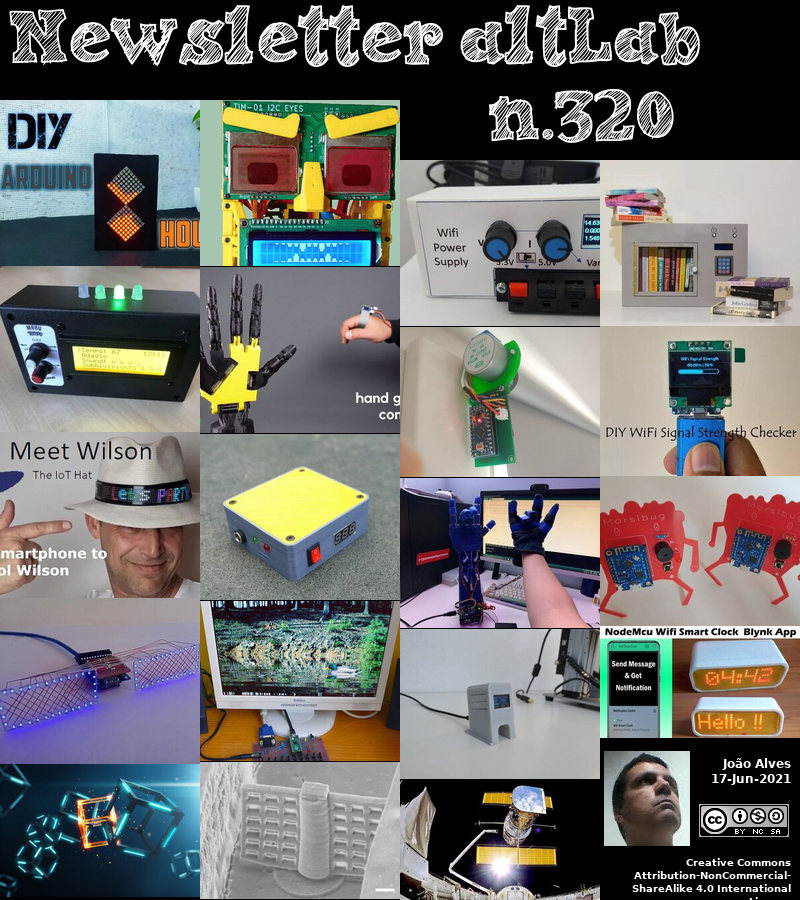2021-06-17 - Nº 320
Editorial
Esta é a Newsletter Nº 320 que se apresenta com o mesmo formato que as anteriores. Se gostar da Newsletter partilhe-a!
Todas as Newsletters encontram-se indexadas no link.
Esta Newsletter tem os seguintes tópicos:
Faz hoje anos que nascia, em 1800, o astrónomo irlandês William Parsons, 3rd Earl of Rosse. Ele construiu o maior telescópio reflector do século XIX. Aprendeu a polir espelhos de metal (1827) e passou os anos seguintes a construir um telescópio de 36 polegadas. Mais tarde, completou um telescópio gigante de 72 polegadas (1845) a que deu o nome de "Leviathan", que permaneceu o maior jamais construído até décadas após a sua morte. Foi o primeiro a resolver a forma espiral dos objectos - anteriormente vistos apenas como nuvens - que muito mais tarde foram identificados como galáxias independentes da nossa própria galáxia Via Láctea e a milhões de anos-luz de distância. O seu primeiro avistamento foi feito em 1845, e em 1850 tinha descoberto mais 13. Em 1848, encontrou e nomeou a Nebulosa de Cancer (porque pensava que se assemelhava a um caranguejo), nome pelo qual ainda é conhecido.
Faz também hoje anos que nascia, em 1821, o químico e conferencista inglês John Henry Pepper. Ele inventou a ilusão "Pepper's Ghost" utilizada em palco para proporcionar o efeito de um actor que aparece como uma imagem transparente e desaparece no ar. Utilizou uma grande chapa de vidro no palco, inclinada a um ângulo de 45 graus em relação ao chão. A utilização de iluminação especial permitiu ao público ver o reflexo de um actor colocado fora do palco, fora da vista directa do público. Pepper aprendeu pela primeira vez a usar o showmanship para o público no Royal Polytechnic Institution de Londres para apresentar demonstrações experimentais de ritmo rápido e surpreendente para aumentar a compreensão do público dos fenómenos em física e química. Na década de 1870, expandiu as suas actividades a uma audiência global, visitando a Austrália, o Canadá e os Estados Unidos.
Faz igualmente hoje anos que nascia, em 1832, o físico e químico inglês William Crookes. Ele descobriu o elemento tálio e mostrou que os raios catódicos eram partículas em movimento rápido, carregadas negativamente. O espaço escuro Crookes é a região escura em torno de um cátodo que faz descargas eléctricas a baixa pressão. Ele inventou o radiómetro (1875) no qual quatro palhetas suspensas numa agulha no vácuo com um lado preto e o outro branco são observadas a rodar pelo efeito da luz incidente. Inventou também o espintiscópio (1903), que revela partículas alfa emitidas pelo rádio, enquanto a luz pisca quando estas incidem sobre uma tela de sulfureto de zinco vista sob ampliação. Os seus interesses incluíam o espiritualismo, mas forneciam uma orientação mais prática para melhorar o saneamento e os fertilizantes artificiais.
Por fim, faz hoje anos que nascia, em 1898, o artista e ilustrador holandês M. C. Escher. Ele ficou famoso pelas suas muitas obras de arte moderna com ilusões de perspectiva inventivas e intrincadas pavimentações e inspirações da matemática. A sua arte é apreciada por milhões de pessoas em todo o mundo, como se pode ver nos muitos websites relativos à sua vida e obra. É mais famoso pelas suas construções ditas impossíveis, tais como Ascendente e Descendente, Relatividade assim como as suas Impressões de Transformação, tais como Metamorfose I, II e III, Céu e Água I ou Répteis.
Nesta semana que passou três astronautas chineses a bordo da nave espacial Shenzhou-12 entraram no módulo central da estação espacial chinesa Tianhe. Depois de Shenzhou-12 ter completado com sucesso um rápido encontro automático e acoplado com o módulo orbital Tianhe, a tripulação de Shenzhou-12 entrou na cápsula orbital a partir da cápsula de retorno da nave espacial. Após uma série de preparativos, os astronautas abriram as escotilhas do nó e do módulo de Tianhe. Às 18:48, Nie Haisheng, Liu Boming e Tang Hongbo tinham entrado um a um no módulo Tianhe, significando que pela primeira vez os chineses tinham entrado na sua própria estação espacial.
Na Newsletter desta semana apresentamos diversas noticias, artigos científicos, projetos de maker assim como alguns videos interessantes. É apresentada a revista HackSpaceMag Nº44 de Julho.
 João Alves ([email protected])
João Alves ([email protected])
O conteúdo da Newsletter encontra-se sob a licença  Creative Commons Attribution-NonCommercial-ShareAlike 4.0 International License.
Creative Commons Attribution-NonCommercial-ShareAlike 4.0 International License.
Novidades da Semana
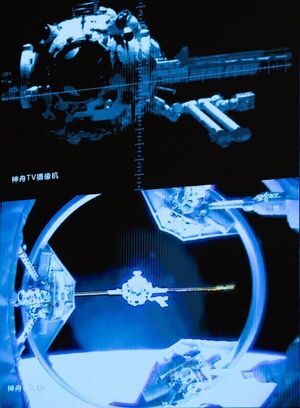
Shenzhou-12 astronauts enter space station core module
"The three Chinese astronauts onboard the Shenzhou-12 spaceship entered the country's space station core module Tianhe on Thursday, according to the China Manned Space Agency (CMSA). After Shenzhou-12 successfully completed a fast automated rendezvous and docking with the orbiting Tianhe module, the Shenzhou-12 crew entered the orbital capsule from the return capsule of the spaceship. After a series of preparations, the astronauts opened the hatches of the node and the Tianhe module. By 6:48 p.m., Nie Haisheng, Liu Boming and Tang Hongbo had entered the Tianhe module one by one, signifying that for the first time the Chinese have entered their own space station, said the CMSA. They will carry out relevant work as planned, the CMSA said. " [...]
Outras Notícias

Fraunhofer goes quantum: IBM’s Quantum System One comes to Europe
"raunhofer-Gesellschaft is betting that Quantum System One will pave the way to future industrial applications of this new way of computation. It should also lead to ever more research and help develop a global quantum-ready workforce. It’s the first step towards commercially scaling IBM’s quantum computing technology. In July, a quantum computer in Japan will join its Fraunhofer cousin, and in the not too distant future one will also be installed at Cleveland Clinic in Ohio. “Quantum computing opens up new possibilities for industry and society,” says Hannah Venzl, the coordinator of Fraunhofer Competence Network Quantum Computing. “Drugs and vaccines could be developed more quickly, climate models improved, logistics and transport systems optimized, or new materials better simulated." [...]

Operations Underway to Restore Payload Computer on NASA's Hubble Space Telescope
"NASA is working to resolve an issue with the payload computer on the Hubble Space Telescope. The computer halted on Sunday, June 13, shortly after 4 p.m. EDT. After analyzing the data, the Hubble operations team is investigating whether a degrading memory module led to the computer halt. The team is preparing to switch to one of several backup modules on Wednesday, June 16. The computer will then be allowed to run for approximately one day to verify that the problem has been solved. The team would then restart all science instruments and return the telescope to normal science operations." [...]

Samsung Researchers Prove the Viability of Commercialized ‘Stretchable’ Devices
"With the establishment of flexible displays behind us, many have asked what the next big development in display technology will be. Recently, free-form displays1 have been gaining traction as next-generation technology that will allow for both high-resolution visuals and portability at the same time. While the technology is still in its nascent stages, significant research has been carried out on stretchable displays (a core technology for free-form displays) that can be stretched in all directions like rubber bands to change their shapes. Stretchable Display and Sensor Breakthroughs On June 4, researchers at the Samsung Advanced Institute of Technology (SAIT), Samsung’s R&D hub dedicated to cutting-edge future technologies, published research2 in the world-renowned journal ‘Science Advances’ about a technology that overcomes the limitations of stretchable devices. Through this study, stable performance in a stretchable device with high elongation was achieved. This research was also the first in the industry to prove the commercialization potential of stretchable devices, given that the technology is capable of being integrated with existing semiconductor processes." [...]
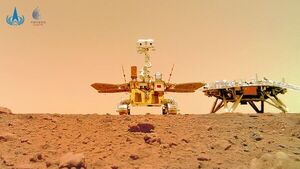
China unveils images of Mars taken by Zhurong rover, marking success of first Mars exploration mission
"China on Friday unveiled the first batch of images from the Tianwen-1 spacecraft's landing on Mars. The images were taken by its Zhurong Mars rover, including a panoramic view of the landing site and terrain of Mars. The release of these images marked a complete success for China's first Mars exploration mission. The images were unveiled at a ceremony held by China's National Space Administration in Beijing. The panoramic view of the landing site is a 360° circular picture taken by the navigation terrain camera on the mast of the rover before it left the landing platform. The image shows that the land near the landing site is flat, and the horizon of Mars can be seen in the distance." [...]

Intel Unveils Infrastructure Processing Unit
"Today during the Six Five Summit, Intel unveiled its vision for the infrastructure processing unit (IPU), a programmable networking device designed to enable cloud and communication service providers to reduce overhead and free up performance for central processing units (CPUs). With an IPU, customers will better utilize resources with a secure, programmable, stable solution that enables them to balance processing and storage. “The IPU is a new category of technologies and is one of the strategic pillars of our cloud strategy. It expands upon our SmartNIC capabilities and is designed to address the complexity and inefficiencies in the modern data center. At Intel, we are dedicated to creating solutions and innovating alongside our customer and partners — the IPU exemplifies this collaboration.” –Guido Appenzeller, chief technology officer, Data Platforms Group, Intel How It Works: The IPU is a programmable network device that intelligently manages system-level infrastructure resources by securely accelerating those functions in a data center. It allows cloud operators to shift to a fully virtualized storage and network architecture while maintaining high performance and predictability, as well as a high degree of control." [...]
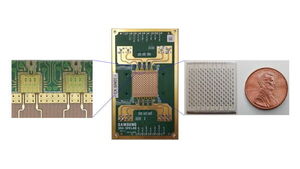
Samsung Electronics and University of California Santa Barbara Demonstrate 6G Terahertz Wireless Communication Prototype
"The demonstration explored the potential of THz spectrum application for 6G wireless communications Samsung Electronics today announced that the company demonstrated the 6G Terahertz (THz) wireless communication prototype in collaboration with the University of California, Santa Barbara (UCSB). At the recent workshop on Terahertz communications at the IEEE International Conference on Communications (ICC 2021), researchers from Samsung Research, Samsung Research America, and the University of California, Santa Barbara (UCSB) introduced the potential impact that THz could have on next-generation 6G technology, demonstrating an end-to-end 140GHz wireless link using a fully digital beamforming solution. “Samsung has been at the forefront of technological innovation and standardization of 5G and 6G. As we shared in our 6G vision white paper last year, we believe new spectrum opportunities at the THz spectrum will become a driving force of 6G technology. This demonstration can be a major milestone in exploring the feasibility of using the THz spectrum for 6G wireless communications,” said Senior Vice President Sunghyun Choi, an IEEE Fellow and Head of the Advanced Communication Research Center at Samsung Research. The THz band includes an enormous amount of available spectrum, which will enable wideband channels with tens of GHz-wide bandwidth." [...]

Samsung Brings Flagship Features to Broader Smartphone Market With LPDDR5 Multichip Package
"Industry’s first LPDDR5 uMCP to be mass produced and deployed across mid- to high-end smartphones, starting this month Samsung uMCP combines LPDDR5 memory and UFS 3.1 NAND storage, providing industry’s highest performance, capacity and efficiency to make 5G functionality accessible to many smartphone users Samsung Electronics, the world leader in advanced memory technology, today announced that it has begun mass producing its latest smartphone memory solution, the LPDDR5 UFS-based multichip package (uMCP). Samsung’s uMCP integrates the fastest LPDDR5 DRAM with the latest UFS 3.1 NAND flash, delivering flagship-level performance to a much broader range of smartphone users. “Samsung’s new LPDDR5 uMCP is built upon our rich legacy of memory advancements and packaging know-how, enabling consumers to enjoy uninterrupted streaming, gaming and mixed reality experiences even in lower-tier devices,” said Young-soo Sohn, vice president of the Memory Product Planning Team at Samsung Electronics. “As 5G-compatible devices become more mainstream, we anticipate that our latest multichip package innovation will accelerate the market transition to 5G and beyond, and help to bring the metaverse into our everyday lives a lot faster.” Based on the latest mobile DRAM and NAND interfaces, Samsung’s uMCP can deliver lightning-fast speed and high storage capacity at very low power. This combination will allow more consumers to immerse themselves in numerous 5G applications that were previously only available on premium flagship models, including advanced photography, graphics-intensive gaming and augmented reality (AR). Such flagship-level capabilities are made possible by a nearly 50% improvement in DRAM performance, from 17 gigabytes per second (GB/s) to 25GB/s, and a doubling of NAND flash performance, from 1.5GB/s to 3GB/s, over the previous LPDDR4X-based UFS 2.2 solution." [...]

Microchip Simplifies Deployment of Wi-Fi 6 Access Points and Small Cell Nodes with First Multiport, Multigigabit PoE Injector
"Organizations can only deploy today’s Wi-Fi® 6 access points (APs) and 5G small cell access nodes where AC power is available or if their switch can deliver both power and data to them as required. Microchip Technology Inc. (Nasdaq: MCHP) has created a more flexible and cost-effective alternative with the first multiport Power over Ethernet (PoE) power sourcing equipment (PSE) injector, also known as a midspan, that enables any multigigabit switch to support these devices’ high powering needs and data rates, with no network configuration or downtime necessary. “Our new family of multiport, multigigabit PoE PSE Injectors offers the easiest and most cost-effective way to install Wi-Fi 6 devices and small cell equipment,” said Iris Shuker, director of Microchip's PoE business unit. “Patented Microchip technology solves the challenge of powering these devices while also supporting their 10 gigabit-per-second data rates. This greatly simplifies deployment of Wi-Fi 6 APs while enabling service providers, for the first time, to quickly and inexpensively install 5G picocells and femtocells wherever they are needed, which is rarely near an AC outlet.” Multigigabit PoE-enabled switches with sufficient power for Wi-Fi 6 devices and small cell equipment are expensive and not widely adopted. A more cost-effective way to inject power into the network for these high-speed devices is to install one of Microchip’s new multiport, multigigabit midspans between them and any standard multigigabit switch." [...]

Market-Optimized 3nm Physical IP for Armv9-based CPUs
"For many decades, the computing industry has been focused on keeping pace with Moore’s Law by packing more compute into smaller areas. As Moore’s Law comes to an end, and new compute applications emerge, specialized processing will be the key to achieving the increased performance, power, and area (PPA) expected across the industry. The recently announced Armv9-A architecture will form the leading-edge of the next 300 billion Arm-based chips. Arm partners are executing on plans for the future of computing today, and already leveraging the secure, powerful processing features of the new Armv9-A architecture to bring their innovations to life in next-generation SoCs. Market segments like premium mobile and hyperscale-cloud that require higher performance and power efficiency to process complex AI-based workloads are at the forefront of this development, and we are enabling their design with optimized physical IP and implementations, Arm POP IP, in TSMC 3nm technology. Recently, a lead Arm partner successfully taped-out a test chip, validating Armv9 physical IP on TSMC 3nm process technology." [...]
Toshiba and Japan Semiconductor Demonstrate Simultaneous Optimization of ESD Tolerance and Power Efficiency for High Voltage LDMOS for Automotive Analog ICs
"Toshiba Electronic Devices & Storage Corporation (“Toshiba”) and Japan Semiconductor Corporation (“Japan Semiconductor”) have together demonstrated a method for improving at the same time both the reliability and the performance of high voltage Laterally Double Diffused MOS (LDMOS), core components of analog ICs used in a wide range of automotive applications, such as motor control drivers. As the electrification of vehicles progresses, including wider deployment of advanced driver assistance systems (ADAS), Toshiba and Japan Semiconductor will be able to offer improved LDMOS cell design based on desired voltages. Details of the achievement were reported at the IEEE-sponsored International Symposium on Power Semiconductor Devices and ICs 2021 (ISPSD 2021), held online. There has been a trade-off in LDMOS design between reliability and performance. It is known that tolerance of electrostatic discharge (ESD), as measured using the human body model (HBM), is improved by increasing the backgate ratio*1 to suppress lateral parasitic bipolar action*2, which degrades HBM tolerance. However, increasing the backgate ratio also increases on-resistance, which degrades performance." [...]

STMicroelectronics Introduces Cost-Efficient NFC Transceiver Enabling New Application Areas and Easing Customer Interaction
"The ST25R3918 from STMicroelectronics is a multi-purpose NFC transceiver supporting passive peer-to-peer functionality and NFC card-emulation mode as well as NFC reader operation. Delivering most of the functionality of the flagship ST25R3916 NFC reader at a highly competitive price, the ST25R3918 enables use cases such as accessory identification for a wide range of applications including power tools and personal healthcare devices where the ST25R3918 interacts seamlessly with ST25 tags. Its close relationship to the ST25R3916 simplifies hardware design and certification. Supporting NFC-A and NFC-F card emulation, the ST25R3918 can be used as an NFC-A/B (ISO 14443A/B) card reader up to high bit rates, and as an NFC-V (ISO 15693) reader up to 53 kbps, as well as ISO 18092 passive initiator and target. The card emulation mode allows support for the newest features available on mobile phones. End customers can use their phones to interact easily with applications that utilize the ST25R3918, including using a simple tap to start apps on the phone." [...]

Renesas Unlocks Personalized Air Quality Experiences With Ultra-Low Power ZMOD4510 Outdoor Air Quality Sensor Platform
"Enhanced Platform Delivers Selective Ozone Detection, Miniature Sensor, and a IP67 Waterproof Package for Wearables, Smartphones, and Industrial Monitoring Devices Renesas Electronics Corporation (TSE:6723), a premier supplier of advanced semiconductor solutions, today expanded its popular ZMOD4510 Outdoor Air Quality (OAQ) gas sensor platform with an IP67-qualifed waterproof package and a new AI-based algorithm that enables ultra-low power selective ozone measurements. The enhanced ZMOD4510 is the industry’s first fully calibrated, miniature digital OAQ sensor solution with selective ozone measurement capabilities, offering visibility into the air quality in users’ immediate environments for a personalized experience. Ozone gas is a significant cause of poor outdoor air quality that poses health risks. Based on Renesas’ new ultra-low power firmware, the enhanced ZMOD4510 can detect specific ozone levels – without reporting on other pollutants – while maintaining power consumption under 200 uW. This selective measurement capability allows devices such as smart watches, phones, and smoke detectors to monitor for harmful ozone gasses typically found outdoors but which can drift indoors through open windows and doors. Optimizing the ZMOD4510 for very low power is key to enabling the longer life cycles required for these types of battery-powered devices." [...]
ON Semiconductor Announces Integrated Solutions for Industrial Motor Drives at APEC 2021
"ON Semiconductor® (Nasdaq:ON), driving energy efficient innovations, announces new, integrated, converter-inverter-power factor correction (PFC) modules for use in industrial motor drives , servo drives and HVAC where they are used to drive motors for applications including fans and pumps. The new NXH50M65L4C2SG and NXH50M65L4C2ESG are transfer−molded power integrated modules (TMPIM) based upon standard aluminum oxide (AI2O3) substrate and enhanced low thermal resistance substrate respectively. Ideally suited to rugged industrial applications with high output power, the modules contain a converter−inverter−PFC circuit consisting of single-phase converter with four 75 A, 1600 V rectifiers. The 3-phase inverter uses six 50 A, 600 V IGBTs with inverse diodes and the dual−channel interleaved PFC comprises two 75 A, 650 V PFC IGBTs with inverse diodes and two 50 A, 650 V PFC diodes. An NTC thermistor is embedded to allow for monitoring of device temperature during operation. As the module is pre-assembled in an optimized layout and configuration, parasitic elements are very small when compared with discrete PCB-based designs, thereby allowing a wide PFC switching frequency range between 18 kHz and 65 kHz." [...]
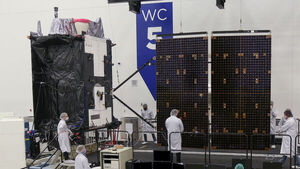
Fifth GPS III Satellite Takes to the Skies
"When you call an Uber, send your friends a snapshot of your location, or use your phone to navigate to a nearby restaurant, what you may not realize is that the signal you’re using is actually provided to you by the U.S. Space Force – and Lockheed Martin. But before it powered your ability to make it successfully to your next destination, GPS was first and foremost intended as a warfighting system. GPS is a “system” in the true sense of the word – it doesn’t just consist of the satellites in orbit beaming down to your phone. It’s a partnership between the satellite, the ground control system, and the user equipment. Lockheed Martin is responsible for designing, building and sustaining the former two elements of the system. Today, GPS signals are utilized by more than 4 billion military, commercial and civil users around the world." [...]
Ciência e Tecnologia

Astronomers spot a ‘blinking giant’ near the centre of the Galaxy
"Astronomers have spotted a giant ‘blinking’ star towards the centre of the Milky Way, more than 25,000 light years away. An international team of astronomers observed the star, VVV-WIT-08, decreasing in brightness by a factor of 30, so that it nearly disappeared from the sky. While many stars change in brightness because they pulsate or are eclipsed by another star in a binary system, it’s exceptionally rare for a star to become fainter over a period of several months and then brighten again. The researchers believe that VVV-WIT-08 may belong to a new class of ‘blinking giant’ binary star system, where a giant star ⎼ 100 times larger than the Sun ⎼ is eclipsed once every few decades by an as-yet unseen orbital companion. The companion, which may be another star or a planet, is surrounded by an opaque disc, which covers the giant star, causing it to disappear and reappear in the sky. The study is published in Monthly Notices of the Royal Astronomical Society." [...]

New method makes generic polymers luminescent
"Hokkaido University researchers have developed a simple method that converts existing generic polymers into luminescent polymers using mechanical force. Researchers from Hokkaido University have successfully developed a new method to give luminescent properties to generic polymers, such as polystyrene and polyethylene. The technique, which was published in the journal Angewandte Chemie International Edition, makes it possible to easily prepare luminescent polymers without using complicated organic synthetic methods. “Luminescent polymers are widely used in modern society, in applications such as organic lasers, solar cells, sensors and bioimaging, but their preparation often requires multiple chemical synthesis steps, which are both time and labor intensive,” explains Professor Hajime Ito, one of the authors of the study and Vice Director of the Institute for Chemical Reaction Design and Discovery (WPI-ICReDD) at Hokkaido University. To overcome this problem, the research team investigated whether luminescent polymers could be prepared using mechanical force as opposed to sophisticated chemical synthesis. “It is well known that mechanically stimulating polymers, for example by grinding or crushing them, generates reactive species called free radicals,” says Associate Professor Koji Kubota from Hokkaido University, a paper co-author." [...]

UK builds first modular quantum brain sensor and records signal
"A team of scientists at the University of Sussex have for the first time built a modular quantum brain scanner, and used it to record a brain signal. This is the first time a brain signal has been detected using a modular quantum brain sensor anywhere in the world. It's a major milestone for all researchers working on quantum brain imaging technology because modular sensors can be scaled up, like Lego bricks. The team have also connected two sensors like 'Lego bricks' proving that whole-brain scanning using this method is within reach - as detailed in their paper, which is published today in pre-print. This has not been possible with the currently commercially available quantum brain sensors from the United States. The modular devices work like play bricks in that they can be connected together." [...]
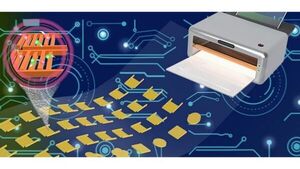
Printing Flexible Wearable Electronics for Smart Device Applications
"The demand for flexible wearable electronics has spiked with the dramatic growth of smart devices that can exchange data with other devices over the internet with embedded sensors, software, and other technologies. Researchers consequently have focused on exploring flexible energy storage devices, such as flexible supercapacitators (FSCs), that are lightweight and safe and easily integrate with other devices. FSCs have high power density and fast charge and discharge rates. Printing electronics, manufacturing electronics devices and systems by using conventional printing techniques, has proved to be an economical, simple, and scalable strategy for fabricating FSCs. Traditional micromanufacturing techniques can be expensive and complex. In Applied Physics Reviews, by AIP Publishing, researchers from Wuhan University and Hunan University provide a review of printed FSCs in terms of their ability to formulate functional inks, design printable electrodes, and integrate functions with other electronic devices." [...]
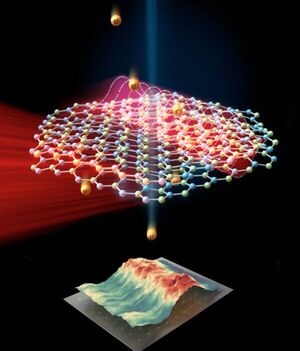
A Spatiotemporal Symphony of Light
"In a Nano Optics Breakthrough, Technion Researchers Observe Sound-Light Pulses in 2D Materials for the first time Haifa, Israel June 11, 2021 – Using an ultrafast transmission electron microscope, researchers from the Technion – Israel Institute of Technology have, for the first time, recorded the propagation of combined sound and light waves in atomically thin materials. The experiments were performed in the Robert and Ruth Magid Electron Beam Quantum Dynamics Laboratory headed by Professor Ido Kaminer, of the Andrew and Erna Viterbi Faculty of Electrical & Computer Engineering and the Solid State Institute. Single-layer materials, alternatively known as 2D materials, are in themselves novel materials, solids consisting of a single layer of atoms. Graphene, the first 2D material discovered, was isolated for the first time in 2004, an achievement that garnered the 2010 Nobel Prize. Now, for the first time, Technion scientists show how pulses of light move inside these materials. Their findings, “Spatiotemporal Imaging of 2D Polariton Wavepacket Dynamics Using Free Electrons,” were published in Science following great interest by many scientists." [...]

Rice lab peers inside 2D crystal synthesis
"Simulations could help molecular engineers enhance creation of semiconducting nanomaterials Scientific studies describing the most basic processes often have the greatest impact in the long run. A new work by Rice University engineers could be one such, and it’s a gas, gas, gas for nanomaterials. Rice materials theorist Boris Yakobson, graduate student Jincheng Lei and alumnus Yu Xie of Rice’s Brown School of Engineering have unveiled how a popular 2D material, molybdenum disulfide (MoS2), flashes into existence during chemical vapor deposition (CVD). Knowing how the process works will give scientists and engineers a way to optimize the bulk manufacture of MoS2 and other valuable materials classed as transition metal dichalcogenides (TMDs), semiconducting crystals that are good bets to find a home in next-generation electronics. Their study in the American Chemical Society journal ACS Nano focuses on MoS2’s “pre-history,” specifically what happens in a CVD furnace once all the solid ingredients are in place. CVD, often associated with graphene and carbon nanotubes, has been exploited to make a variety of 2D materials by providing solid precursors and catalysts that sublimate into gas and react." [...]
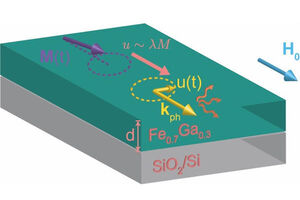
Researchers discover a key cause of energy loss in spintronic materials
"University of Minnesota-led research discovered that the interaction between magnetism and sound particles in spintronic devices can lead to damping, or the loss of energy, a process depicted in the figure above. The finding will ultimately allow engineers to develop more efficient spintronic devices in the future. Photo credit: Bill Peria, University of Minnesota A study led by University of Minnesota Twin Cities researchers uncovered a property of magnetic materials that will allow engineers to develop more efficient spintronic devices in the future. Spintronics focuses on using the magnetic “spin” property of electrons instead of their charge, which improves the speed and efficiency of devices used for computing and data storage. The research is published in Physical Review B, a peer-reviewed scientific journal published by the American Physical Society. One of the major roadblocks in developing better spintronic devices is an effect called “damping,” in which the magnetic energy essentially leaks out of the materials, causing them to be less efficient." [...]
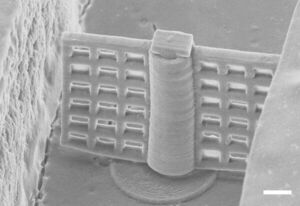
Researchers 3D Print Rotating Microfilter for Lab-on-a-Chip Applications
"With filter modes that can be switched via a magnetic field, device shows promise for cell sorting Researchers have fabricated a magnetically driven rotary microfilter that can be used to filter particles inside a microfluidic device. They made the tiny turning filter by creating a magnetic material that could be used with a very precise 3D printing technique known as two-photon polymerization. Microfluidic devices, also known as lab-on-a-chip devices, can be used to perform multiple laboratory functions inside a chip that usually measures a few square centimeters or less. These devices contain intricate networks of microfluidic channels and are becoming more and more complex. They may be useful for a variety of applications such as screening molecules for therapeutic potential or performing blood tests that detect disease. “By changing the direction of external magnetic field, the microfilter we made can be remotely manipulated on demand to either filter certain-sized particles or to allow them all to pass,” said Dong Wu, a member of the research team from the University of Science and Technology of China." [...]

Combining classical and quantum computing opens door to new discoveries
"New computing method opens the door to different algorithms and experiments Researchers have discovered a new and more efficient computing method for pairing the reliability of a classical computer with the strength of a quantum system. This new computing method opens the door to different algorithms and experiments that bring quantum researchers closer to near-term applications and discoveries of the technology. “In the future, quantum computers could be used in a wide variety of applications including helping to remove carbon dioxide from the atmosphere, developing artificial limbs and designing more efficient pharmaceuticals,” said Christine Muschik, a principal investigator at the Institute for Quantum Computing (IQC) and a faculty member in physics and astronomy at the University of Waterloo. The research team from IQC in partnership with the University of Innsbruck is the first to propose the measurement-based approach in a feedback loop with a regular computer, inventing a new way to tackle hard computing problems. Their method is resource-efficient and therefore can use small quantum states because they are custom-tailored to specific types of problems. Hybrid computing, where a regular computer’s processor and a quantum co-processor are paired into a feedback loop, gives researchers a more robust and flexible approach than trying to use a quantum computer alone." [...]

UW researchers can turn a single photo into a video
"Sometimes photos cannot truly capture a scene. How much more epic would that vacation photo of Niagara Falls be if the water were moving? Researchers at the University of Washington have developed a deep learning method that can do just that: If given a single photo of a waterfall, the system creates a video showing that water cascading down. All that’s missing is the roar of the water and the feeling of the spray on your face. The team’s method can animate any flowing material, including smoke and clouds. This technique produces a short video that loops seamlessly, giving the impression of endless movement." [...]
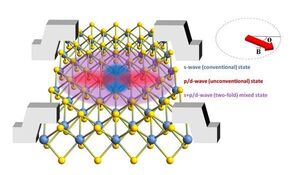
Collaboration uncovers unique properties of a promising new material
"A collaboration that includes four faculty members of the School of Physics and Astronomy, Vlad Pribiag, Fiona Burnell, Rafael Fernandes and Ke Wang, has discovered that a unique superconducting material has unforeseen properties when it was studied in a very thin layer. It is not uncommon for materials to behave differently when they are at a very small size, but this material has potentially beneficial properties. A recent study of niobium diselenide (NbSe2) by the collaboration found that the material in 2D form (a very thin substrate only a few atomic layers thick) is a more resilient superconductor because it has a two-fold symmetry, very different from thicker samples of the same material. Motivated by Fernandes and Burnell’s theoretical prediction of exotic superconductivity in this 2D material, Pribiag and Wang started to investigate atomically-thin 2D superconducting devices. “We expected it to have a six fold rotational pattern, like a snowflake.” Wang says. Despite the six-fold structure, it only showed two fold behavior in the experiment.” “This was one of the first times it was seen in a real material,” Pribiag says." [...]

Discovery of a rare superconductor may be vital for the future of quantum computing
"Research led by Kent and the STFC Rutherford Appleton Laboratory has resulted in the discovery of a new rare topological superconductor, LaPt3P. This discovery may be of huge importance to the future operations of quantum computers. Superconductors are vital materials able to conduct electricity without any resistance when cooled below a certain temperature, making them highly desirable in a society needing to reduce its energy consumption. They manifest quantum properties on the scale of everyday objects, making them highly attractive candidates for building computers which use quantum physics to store data and perform computing operations, and can vastly outperform even the best supercomputers in certain tasks. As a result, there is an increasing demand from leading tech companies like Google, IBM and Microsoft to make quantum computers on an industrial scale using superconductors. However, the elementary units of quantum computers (qubits) are extremely sensitive and lose their quantum properties due to electromagnetic fields, heat and collisions with air molecules." [...]
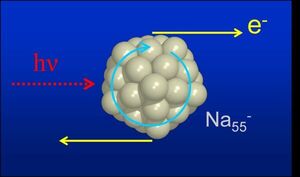
The Electron Merry-Go-Round
"Freiburg researchers find new mechanism for classical behavior of many-particle quantum systems Photoemission is a property of metals and other materials that emit electrons when struck by light. Electron emission after light absorption was already explained by Albert Einstein. But since this effect is a highly complex process, scientists have still not been able to fully elucidate its details. Prof. Dr. Bernd von Issendorff and his team at the University of Freiburg’s Institute of Physics have now succeeded in detecting a previously unknown quantum effect in the angular distributions of photoelectrons from cryogenic mass-selected metal clusters. The angular distributions resemble those of classical particles, a behavior that is surprisingly explainable by the strong electron-electron interaction in these many-electron systems. The researchers published this finding in the current issue of Physical Review Letters." [...]
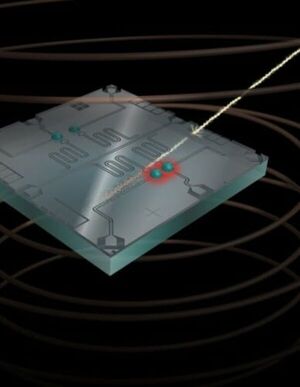
Correlated errors in quantum computers emphasize need for design changes
"Quantum computers could outperform classical computers at many tasks, but only if the errors that are an inevitable part of computational tasks are isolated rather than widespread events. Now, researchers at the University of Wisconsin–Madison have found evidence that errors are correlated across an entire superconducting quantum computing chip — highlighting a problem that must be acknowledged and addressed in the quest for fault-tolerant quantum computers. The researchers report their findings in a study published June 16 in the journal Nature. Importantly, their work also points to mitigation strategies. “I think people have been approaching the problem of error correction in an overly optimistic way, blindly making the assumption that errors are not correlated,” says UW–Madison physics Professor Robert McDermott, senior author of the study. “Our experiments show absolutely that errors are correlated, but as we identify problems and develop a deep physical understanding, we’re going to find ways to work around them.” The bits in a classical computer can either be a 1 or a 0, but the qubits in a quantum computer can be 1, 0, or an arbitrary mixture — a superposition — of 1 and 0." [...]

Miniature robots controlled by magnetic fields
"A team of scientists at NTU Singapore has developed millimetre-sized robots that can be controlled using magnetic fields to perform highly manoeuvrable and dexterous manipulations. This could pave the way to possible future applications in biomedicine and manufacturing. The research team created the miniature robots by embedding magnetic microparticles into biocompatible polymers — non-toxic materials that are harmless to humans. The robots are ‘programmed’ to execute their desired functionalities when magnetic fields are applied. The made-in-NTU robots improve on many existing small-scale robots by optimizing their ability to move in six degrees-of-freedom (DoF) – that is, translational movement along the three spatial axes, and rotational movement about those three axes, commonly known as roll, pitch and yaw angles. While researchers have previously created six DoF miniature robots, the new NTU miniature robots can rotate 43 times faster than them in the critical sixth DoF when their orientation is precisely controlled." [...]
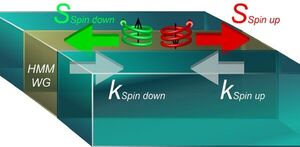
Near-field routing of hyperbolic metamaterials
"Flexible control of the propagating direction of near-field light can be realized with hyperbolic metamaterials, using an all-electric metasource Near-field light is invisible light at the subwavelength scale. Harnessed for a variety of practical applications, such as wireless power transfer, near-field light has an increasingly significant role in the development of miniature on-chip photonic devices. Controlling the direction of near-field light propagation has been an ongoing challenge that is of fundamental interest in photonics physics and can significantly advance a variety of applications. So far, propagation of near-field light in a single direction is achieved by specific interactions between the electric dipole and the magnetic dipole in a system, which has led to inevitable complexities in device design. Hyperbolic metamaterials (HMMs), an important class of artificial anisotropic material with hyperbolic isofrequency contours, have attracted attention due to their unique ability to control near-field light by enabling subwavelength confinement of electromagnetic waves. Large wave-vector modes in HMMs are of particular interest because those modes are easier to integrate and have a smaller loss of energy at transfer." [...]
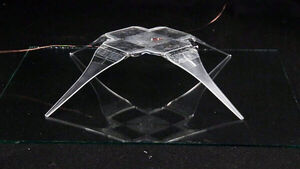
Electrohydraulic arachno-bot a fascinating lightweight
"Goodbye, bulky components and connectors: A team of scientists at the Max Planck Institute for Intelligent Systems in Germany and at the University of Boulder in Colorado in the US has now found a new way to exploit the principles of spiders’ joints to create lightweight robots. Stuttgart/Boulder – It is not the first time that spiders have served as biological models in the research field of soft robotics. The hydraulic actuation mechanisms they apply to move their limbs when weaving their web or hunting for prey give them powers many roboticists and engineers have drawn inspiration from. A team of researchers at the Max Planck Institute for Intelligent Systems and at the University of Boulder in Colorado in the US has now found a new way to exploit the principles of spiders’ joints to drive articulated robots without any bulky components and connectors, which weigh down the robot and reduce portability and speed. Their slender and lightweight simple structures impress by enabling a robot to jump 10 times its height. At the end of May, the team’s work titled “Spider-inspired electrohydraulic actuators for fast, soft-actuated joints” was published in Advanced Science." [...]

Quantum-nonlocality at all speeds
"The phenomenon of quantum nonlocality defies our everyday intuition. It shows the strong correlations between several quantum particles some of which change their state instantaneously when the others are measured, regardless of the distance between them. While this phenomenon has been confirmed for slow moving particles, it has been debated whether nonlocality is preserved when particles move very fast at velocities close to the speed of light, and even more so when those velocities are quantum mechanically indefinite. Now, researchers from the University of Vienna, the Austrian Academy of Sciences and the Perimeter Institute report in the latest issue of Physical Review Letters that nonlocality is a universal property of the world, regardless of how and at what speed quantum particles move. It is easy to illustrate how correlations can arise in everyday life. Imagine that each day of the month you send two of your friends, Alice and Bob, a toy engine of a set of two for their collection." [...]
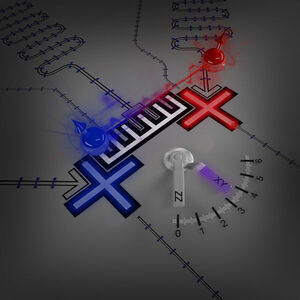
Clearing the way toward robust quantum computing
"MIT researchers make a major advance toward fully realizing quantum computation. MIT researchers have made a significant advance on the road toward the full realization of quantum computation, demonstrating a technique that eliminates common errors in the most essential operation of quantum algorithms, the two-qubit operation or “gate.” “Despite tremendous progress toward being able to perform computations with low error rates with superconducting quantum bits (qubits), errors in two-qubit gates, one of the building blocks of quantum computation, persist,” says Youngkyu Sung, an MIT graduate student in electrical engineering and computer science who is the lead author of a paper on this topic published today in Physical Review X. “We have demonstrated a way to sharply reduce those errors.” In quantum computers, the processing of information is an extremely delicate process performed by the fragile qubits, which are highly susceptible to decoherence, the loss of their quantum mechanical behavior. In previous research conducted by Sung and the research group he works with, MIT Engineering Quantum Systems, tunable couplers were proposed, allowing researchers to turn two-qubit interactions on and off to control their operations while preserving the fragile qubits. The tunable coupler idea represented a significant advance and was cited, for example, by Google as being key to their recent demonstration of the advantage that quantum computing holds over classical computing. Still, addressing error mechanisms is like peeling an onion: Peeling one layer reveals the next." [...]

Portable technology offers boost for nuclear security, arms control
"MIT team devises compact, affordable system for identifying elemental composition of nuclear and other materials. About five years ago, Areg Danagoulian, associate professor in the MIT Department of Nuclear Science and Engineering (NSE), became intrigued by a technique developed by researchers at Los Alamos National Laboratory that uses a neutron beam to identify unknown materials. “They could look into a black box containing uranium and say what kind and how much,” says Danagoulian, who directs MIT’s Laboratory of Applied Nuclear Physics (LANPh). “I was thinking about the problem of verifying nuclear material in warheads, and it just dawned on me, this amazing technology could be applied to what we’re working on.” But there was a problem: This method, called neutron resonance transmission analysis (NRTA), requires an enormous, expensive apparatus, limiting its utility for the kind of on-site nuclear material applications Danagoulian and his research colleagues focus on. To leapfrog this obstacle, they determined to make NRTA technology portable. A paper describing the results of this effort — a first-of-kind, mobile NRTA apparatus with the ability to detect the elemental composition of specific materials — appears in the May 13 edition of Physical Review Applied." [...]

Novel chirped pulses defy ‘conventional wisdom’
"Rochester researchers advance groundbreaking technique first pioneered at the Laboratory for Laser Energetics. The 2018 Nobel Prize in Physics was shared by researchers who pioneered a technique to create ultrashort, yet extremely high-energy laser pulses at the University of Rochester. Now researchers at the University’s Institute of Optics have produced those same high-powered pulses—known as chirped pulses—in a way that works even with relatively low-quality, inexpensive equipment. The new work could pave the way for: Better high-capacity telecommunication systems Improved astrophysical calibrations used to find exoplanets Even more accurate atomic clocks Precise devices for measuring chemical contaminants in the atmosphere In a paper in Optica, the researchers describe the first demonstration of highly chirped pulses created by a using a spectral filter in a Kerr resonator—a type of simple optical cavity that operates without amplification. These cavities have stirred wide interest among researchers because they can support “a wealth of complicated behaviors including useful broadband bursts of light,” says coauthor William Renninger, assistant professor of optics. By adding the spectral filter, the researchers can manipulate a laser pulse in the resonator to widen its wavefront by separating the beam’s colors." [...]

How a supermassive black hole originates
"Supermassive black holes, or SMBHs, are black holes with masses that are several million to billion times the mass of our sun. The Milky Way hosts an SMBH with mass a few million times the solar mass. Surprisingly, astrophysical observations show that SMBHs already existed when the universe was very young. For example, a billion solar mass black holes are found when the universe was just 6% of its current age, 13.7 billion years. How do these SMBHs in the early universe originate? A team led by a theoretical physicist at the University of California, Riverside, has come up with an explanation: a massive seed black hole that the collapse of a dark matter halo could produce." [...]

AI System-On-Chip Runs On Solar Power
"CSEM engineers have developed an integrated circuit that can carry out complicated artificial-intelligence operations like face, voice and gesture recognition and cardiac monitoring. Powered by either a tiny battery or a solar panel, it processes data at the edge and can be configured for use in just about any type of application AI is used in an array of extremely useful applications, such as predicting a machine’s lifetime through its vibrations, monitoring the cardiac activity of patients and incorporating facial recognition capabilities into video surveillance systems. The downside is that AI-based technology generally requires a lot of power and, in most cases, must be permanently connected to the cloud, raising issues related to data protection, IT security and energy use. CSEM engineers may have found a way to get around those issues, thanks to a new system-on-chip they have developed. It runs on a tiny battery or a small solar cell and executes AI operations at the edge – i.e., locally on the chip rather than in the cloud. What’s more, their system is fully modular and can be tailored to any application where real-time signal and image processing is required, especially when sensitive data are involved." [...]
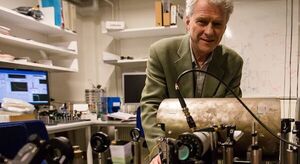
New invention keeps qubits of light stable at room temperature
"Researchers from University of Copenhagen have developed a new technique that keeps quantum bits of light stable at room temperature instead of only working at -270 degrees. Their discovery saves power and money and is a breakthrough in quantum research. As almost all our private information is digitalized, it is increasingly important that we find ways to protect our data and ourselves from being hacked. Quantum Cryptography is the researchers’ answer to this problem, and more specifically a certain kind of qubit – consisting of single photons: particles of light. Single photons or qubits of light, as they are also called, are extremely difficult to hack. However, in order for these qubits of light to be stable and work properly they need to be stored at temperatures close to absolute zero – that is minus 270 C – something that requires huge amounts of power and resources." [...]

Unlocking the potential of blockchain technology
"Algorand uses a unique architecture developed by MIT Professor Silvio Micali to offer a decentralized, secure, and scalable blockchain. The Republic of the Marshall Islands is a country of around 50,000 people spread across more than 1,000 islands in a remote part of the Pacific Ocean. The country relies heavily on cross-border finance and trade, and the complexities of that system can make it difficult for citizens to get certain goods and financial services efficiently. Now the federal government is seeking to become the first to issue a national digital currency using blockchain technology. Officials hope the move helps citizens avoid high transaction fees, simplifies compliance with international partners, and protects against inflation (the currency will have a fixed supply rate). The new currency will be based on blockchain technology developed by Silvio Micali, the Ford Professor of Engineering in MIT’s Computer Science and Artificial Intelligence Laboratory (CSAIL), and commercialized by Micali’s startup, Algorand." [...]

Novel Materials: Sound Waves Traveling Backwards
"Acoustic waves in gases, liquids, and solids usually travel at an almost constant speed of sound. So-called rotons are an exception: their speed of sound changes significantly with the wavelength, and it is also possible that the waves travel backwards. Researchers at Karlsruhe Institute of Technology (KIT) are studying the possibilities of using rotons in artificial materials. These computer-designed metamaterials, produced by ultra-precise 3D laser printing, might be used in the future to manipulate or direct sound in ways that have never been possible before. A report on the researchers’ work has been published in Nature Communications. (DOI: 10.1038/s41467-021-23574-2) Rotons are quasiparticles, which means that they behave similarly to free particles." [...]
Documentação
A documentação é parte essencial do processo de aprendizagem e a Internet além de artigos interessantes de explorar também tem alguma documentação em formato PDF interessante de ler. Todos os links aqui apresentados são para conteúdo disponibilizado livremente pelo editor do livro.

HackSpace magazine #44
"When Newton spoke of standing on the shoulder of giants, he might have been thinking of the Raspberry Pi Pico and Arduino. We delve deep into the Arduino ecosystem and find out how to harness its power for your next Pico project. Get excited about the possibilities of machine learning with Shawn Hymel Fame, fortune and glory with Simone Giertz and her brand-new sensible builds WinDIY: a beautiful, Quixotic tilt at building a home-made 3D printed windmill Send signals to USB via the humble web browser … and loads more! " [...]
Projetos Maker
Diversos Projetos interessantes.
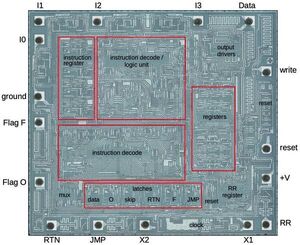
A one-bit processor explained: reverse-engineering the vintage MC14500B
"The Motorola MC14500B1 is a 1-bit processor introduced in 1976. While a 1-bit processor might seem almost useless,2 it was marketed as an Industrial Control Unit for applications that made simple decisions based on Boolean logic, for example, air conditioning, motor control, or traffic lights. The die photo below shows the processor under a microscope. This silicon appears greenish, while the white lines on top are the metal layer that wires the transistors together. The 16 black spots around the edges are the bond wires that connect the chip to its 16 external pins. The MC14500B has roughly 500 transistors, very few for a microprocessor." [...]

Low Profile 2 Channel Solid State Relay for AC Loads
"This project offers an extremely compact solution for interfacing 2 high voltage resistive or inductive loads. At a low profile, this is the most compact & versatile optically isolated 2 channel solid state relay system. The circuit consists of 2x Triacs and isolated Triac drivers. The circuit is compatible with TTL input signals and controls 90V-220V AC loads. Sscrew terminal connectors are provided for an easy connection of the AC loads and AC supply input. Interfacing an Arduino/Micro-controller or other circuit is easy using the 4 Pin header connector." [...]

Wilson - the IoT Hat
"Hi There, Recently, I finished up on my DIY project Wilson: the IoT hat. Because of the big fun I had creating and using this IoT hat, and given the wonderful feedback it provided to the wearer, I really want to share this project with you. Wilson is a hat equipped with a multicolor LED matrix and some electronics. It comes with a smartphone app to control it. Thus you can show different messages in different styles by using your own phone. You can also program Wilson to display incoming Text messages." [...]
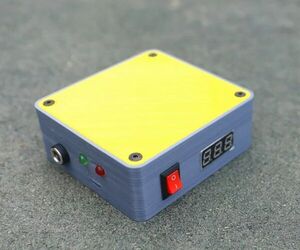
DIY Mini UPS for WiFi Router V4.0
"The pandemic COVID-19 outbreak forced companies to continue with work-from-home policy to maintain social distancing and for business continuity. More and more of us are working from home these days, and that means your home's WiFi networks are more important than ever. Anyone with a fixed-line connection will know that their WiFi drops whenever the power goes out. It is annoying if you are in an important meeting/webinar through Zoom, WebEx, or MS-Team, and there is an interruption due to power cuts. Solutions : 1. Using a conventional UPS ( Bulky and Costly ) 2." [...]
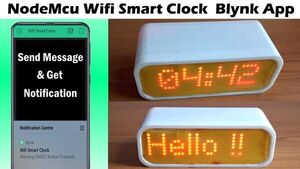
Home Security Smart Clock IoT Emergency App Notification
"I made a Clock that not only display Time,Date, Temp & Hum but you can send message to the clock via Mobile App (Blynk) from anywhere in the World as long as you are connected to internet. And you can also alert by Pressing Panic Button in Clock a Notification Alert will be sent to Mobile instantly through internet. Good for Home Security if you have kid or elderly person in home alone. In Emergency they can alert you by just pressing the button at the back of the Clock. It also work offline showing current time ,temp humidity. Two way communication." [...]
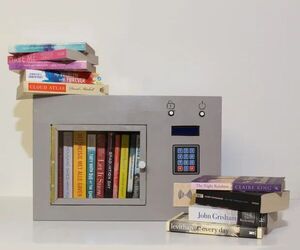
Book Conservation Chamber Using Raspberry Pi
"Hello everyone! For a school project at MCT Howest Kortrijk, I made a Book Conservation Chamber. This is a climate controlled box in which you can store books. The reason why I choose to make this is because a lot of people put their old books in the basement or in the attic. However, most basements are too humid to store books in while the temperature in the attic can be too high, especially during the summer. In this instructable you can find the step by step process to recreate this project." [...]

How to Make a Metal Bender
"This project is a metal bender that I have made to bend stainless steel bars. It can also be used with another materials like metal wires. The bending tool can be replaced without cutting and welding, so if it breaks or you need to bend other size of materials you can make another tool. I hope you like it! Materials: - Carbon steel flat bar 5/8’’ x 1/8’’ - Flat bar 1-1/4’’ x 3/16’’ - Flat bar 2-1/2’’ x 1/4’’ - Round bar diam. 15mm." [...]
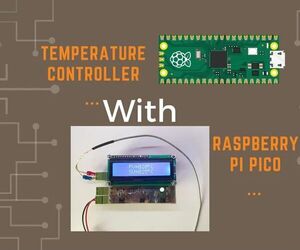
Raspberry Pi Pico Based Temperature Controller
"Hi, everybody. Ok, I know there are so many temperature controllers with different software and hardware systems over the internet, but this can be interesting for you as I used raspberry pi pico as the central controller. One of my friends has a refrigerated warehouse, and the controller used in the mentioned warehouse was broken. I told him that I would build you a controller. As I am a fan of C language and ARM-Cortex microcontrollers, At first, I decided to use STM32 for this purpose. By chance, I saw that I bought a raspberry pi pico a while ago, and I thought it would be fun if I use the raspberry pi to overcome this project." [...]
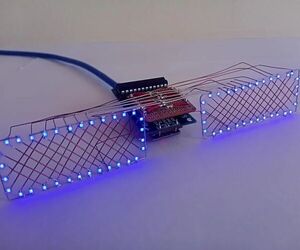
LED Circuit Sculpture
"While surfing on social media I got to know about circuit sculpture where in we create freeform structure out of electronic components which resemble real life objects. It can anything like a car, tree, humanoid object or even a satellite. These sculptures can be used to give user some data in fancy way or even can used as decorative piece to keep in your home as I did. The idea is to use LEDs of single color to display some interesting animations. LEDs will be the standard 0805 package mono color blue LEDs, smaller package means more LEDs. To control LEDs, max7219 module will be used which uses multiplexing method to control large number of LEDs." [...]
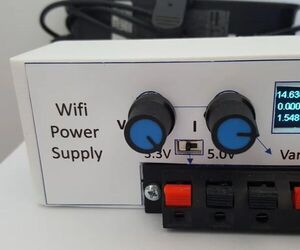
Digital Controlled Bench Power Supply
"There have been quite a few nice power supply projects based around the XL4015 buck converter module. It is a great module for this type of project as it has a wide range of voltage output and decent current capability. It is also available with modules that give multi-turn potentiometer setting of the voltage and extra circuitry to allow for an adjustable current limit. The difference with this instructable is that I have made it digitally controlled on both the voltage and current limit settings and provide for measurement and display of the voltage and actual current being drawn. The controller used is an ESP8266 module which means it also gets a web interface and opens up more possibilities for control. This gives it the following features: - Output voltage digitally settable between 1.25 and 19.0V - Current output up to 5A (4A more realistic to avoid thermal shutdown)." [...]

Hourglass Using Arduino
"In ancient times people used Hourglass to measure the passage of time. Hourglass is a simple device that consists of two glass bulbs that are connected vertically with a narrow neg and that allows the flow of sand or fluid from top to bottom. most of the time the flow duration is about one hour that's why we call hourglass. That's enough why I am taking this because this tutorial is about How to build a digital Hourglass using Arduino. let's start with gathering all components first we need a brain to control everything here I am going to use an Arduino because it has enough digital io pins also Arduino supports i2c. next to detect the orientation we need an accelerometer in this case I am going with ADXL335 3 axis accelerometer." [...]

Webserver Using Pi Pico and ESP01
"ESP-01 WiFi module is developed by encapsulates Tensilica L106 integrates industry Clock speed support 80 MHz, 160 MHz, supports the RTOS, integrated Wi The module supports standard IEEE802.11 add modules to an existing device networking or building a separate network controller. ESP8266 is high integration wireless SOCs, designed for space and power-constrained mobile platforms It provides unsurpassed ability to embed Wi application, with the lowest cost, and minimal space requirement. ESP8266EX offers a complete and self or to offload Wi-Fi networking functions from another application processor When ESP8266EX hosts the application, it boots up directly from an external flash. It has improved the performance of the system in such applications. Alternately, serving as a Wi-Fi adapter, wireless internet access can be added to any microcontroller-based design with simple connectivity (SPI/SDIO or I2C/UART interface). http://www.ai-thinker.com Ai-thinker Team." [...]

Simple AM Radio Transmitter & Receiver
"In this project we will keep it simple when it comes to wireless audio communication. Instead of trying to use an nRF24 or RF modules, we will go back to the old days in which they used AM radios. I will show you how such amplitude modulation works and along the way show you how to build a super simple AM transmitter and receiver. Let's get started! WARNING: Always check your local law if you want to transmit something with AM! Sending on certain frequencies and thus blocking other licensed transmitters can be illegal." [...]
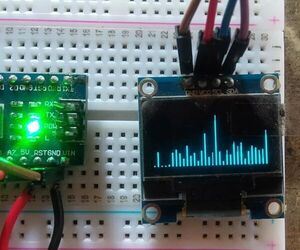
Arduino OLED Spectrum Analyzer
"Today I am make an Arduino OLED Spectrum Analyzer its work with 0 to 3.3v Analog input. This is very smooth and clear Visualization of audio frequencies. This is very important to make an audio spectrum analyser for DVD Music player, IPod, MP3 player and other Music player not only its look good it also represents any kind of music. You can make a box to fit it and attached in car or anywhere you want but I make just simple in breadboard. Note: This project is only for simple audio device, a Real Spectrum Analyser devices are use in Microwave signal, Radar Signal, Dish Antenna Signal, Cable frequencies Signal, etc. Do not try to use for these proposes your Arduino will burn or crash and it cause permanently Damage." [...]

Infrared TV Remote Using ESP32(with Android App)
"The remote control from my TV was worn out and beginning to malfunction. As it was an older model, a new remote could not be purchased. So, instead, I decided to make my own TV remote to replace it. In this tutorial, we will make an InfraRed remote, using the ESP32, which can be controlled with my app on the Google Play Store (https://bit.ly/34kJ3rF). The app will work with almost any microcontroller, but I decided to use the ESP32 as it has Bluetooth and Wi-Fi functionality along with the serial functionality of most microcontrollers. The programs in this tutorial are compatible with most Arduino based microcontrollers, so this project will work on most devices." [...]
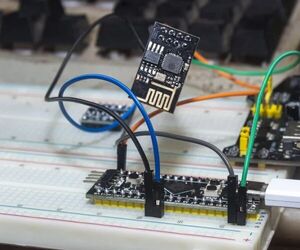
Create a Webserver Using ESP01 and STM32F401CCUx
"ESP-01 WiFi module is developed by encapsulates Tensilica L106 integrates industry Clock speed support 80 MHz, 160 MHz, supports the RTOS, integrated Wi The module supports standard IEEE802.11 add modules to an existing device networking, or building a separate network controller. ESP8266 is high integration wireless SOCs, designed for space and power-constrained mobile platform It provides unsurpassed ability to embed Wi application, with the lowest cost, and minimal space requirement. ESP8266EX offers a complete and self or to offload Wi-Fi networking functions from another application processor When ESP8266EX hosts the application, it boots up directly from an external flash. It has improved the performance of the system in such applications. Alternately, serving as a Wi-Fi adapter, wireless internet access can be added to any microcontroller-based design with simple connectivity (SPI/SDIO or I2C/UART interface). http://www.ai-thinker.com Ai-thinker Team." [...]
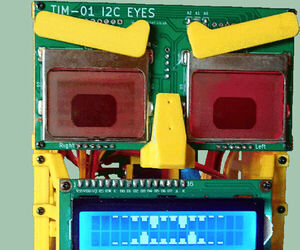
Making a Prototype With Arduino (TIM-01 EYES)
"I have been designing and building a robot. It got to the stage where it was time to do a head for it, but before I did the head I needed to design some Eyes for it using the Nokia screens found cheaply on eBay. There was certain criteria I wanted this project to meet. One of the criteria was that I wanted to control the eyes via I2C (Two Wire). This instruction is on how to make the prototype, before making the PCB you see above. Some things needed are: 2 x Nokia Screens." [...]
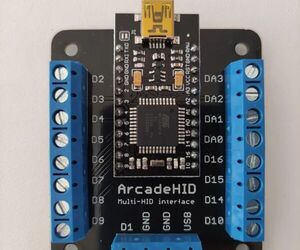
ArcadeHID - Multi-HID Arcade Interface
"If you are an arcade enthusiast you surely know how important is to have the right peripheral for the right game. Genuine arcade controls are not plug-and-play, and special interfaces are needed to convert user inputs into something PC's can recognize and handle. There are a lot of commercial products to choose from, and sometimes it could be difficult to make the right choice. In this Instructable I will show you how easy it is to interface most common Arcade peripherals to Arduino, expecially with the use of this simple shield: ArcadeHID. I will also share with you a link to have ArcadeHID's printed circuit board manufactured at PCBWay, who kindly sponsored it. Let's do that!" [...]
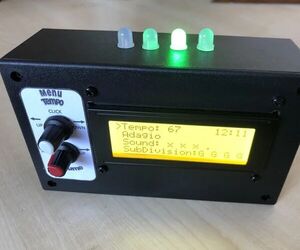
Piano Metronome
"This project was conceived of after I examined the types and styles of various off-the-shelf Metronomes. I am currently learning to play the piano and having a Metronome in order to keep time was necessary. I felt sure that I could build one based on a standard Arduino Uno R3 board. The resultant Metronome has a combined light and sound feature which can be customized to reflect the tempo of the beat. While V1 of the project is complete a V2 is being considered based on some new features such as adding a 18650 Battery shield to allow charging of the batteries via a USB charging cable. I added a simple time display feature in this version, however a future version could include the time in providing a fixed number of beats option." [...]

Hand Gesture Controller for Robotic
"The hand gesture controller makes it possible to control applications using hand tilt angle values. Actually, the hand gesture controller uses an accelerometer, it is possible to use it wherever tilt is provided and control projects. For example, controlling with head movements other than hand movements. It also allows you to do this control wirelessly. Let's take a look at the video on how it works. The Hand Gesture Controller includes an accelerometer and it detects the motion by comparing the acceleration on any axis with set thresholds.The accelerometer can measure the static acceleration of gravity in tilt-sensing projects." [...]
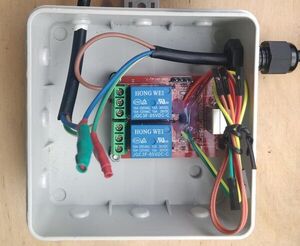
Automatic USB mains switch for USB-controlled power strip
"I wanted to buy a USB-controlled power strip which shuts the devices down when the PC is put to sleep. Life is not so easy: all available USB power strips are quite dumb - they simply use +5 V from USB port to drive the relay. The problem is that most motherboards don’t disable USB supply voltage in sleep mode; the PC has to be turned off completely to be that case. I realized I had to build custom switch which detects USB bus inactivity. This great tutorial about USB physical layer specifies that host generates start-of-frame packet every millisecond, otherwise the device should enter suspend mode. Communication ceases when computer is suspended." [...]

Build an Auduino Step Sequencer
"Kids these days, with their techno musics... am I right? Back in my day a synthesizer took up a whole room. Nowadays you can download one on your computerphone and be dubstepping by lunchtime. Okay, I kind of am one of those kids. I can't get enough 'bleeps' and 'bloops'. So, when I came across the Auduino project, a grain synthesizer for Arduino, I was excited to put one together." [...]

Automatic Window Roller Blinds
"Automatic window roller blinds that can be controlled wirelessly by a small remote, web interface or RESTful API. The project consist of 3 parts: Motor: the part that receives commands and moves the blinds Remote: a small remote to control the motor Web interface: an ESP32 running a web interface that can be used to control the motor from any browser in the network Making your own For this project you will need a 3D printer, patience, fair soldering skills and some experience with Arduino and Platform IO. Automatic window roller blinds that can be controlled wirelessly using a NRF24L01 module. Controlled either by a small remote, web interface or RESTful API. Built around an Arduino pro mini and a cheap stepper motor. How to use it This assembly replaces the side of the roller blinds with the string." [...]

Automatic Water Level Controller for Pump using 555 Timer IC
"Automatic water level controller for the submersible pump and overhead tank with 555 timer IC. Also check the underground tank water level. In this mini electronics project, I have shown how to make an automatic water level controller for the submersible pump and overhead tank with a 555 timer circuit. This automatic water pump controller also checks the water level of the underground tank, before starting the pump. And there is also an emergency stop switch to stop the water pump manually. I have used a 30A relay to easily control up to 1 HP pump with this simple automatic pump controller." [...]
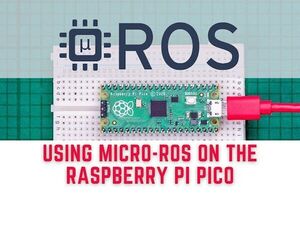
Using micro-ROS on the Raspberry Pi Pico
"Raspberry Pi Pico can communicate with a ROS2 graph natively via micro-ROS... with ROS2 development using VSCode Running micro-ROS on Raspberry Pi Pico In this post, we'll look at how the Raspberry Pi Pico can communicate with a ROS2 graph natively via micro-ROS. In VSCode, we'll create a project, build it, and upload it to the microcontroller. As a result, we'll presume you're comfortable with ROS2 development using VSCode. Running ROS2 on RP2040 microcontrollers. The Raspberry Pi Pico with RP2040 chip is totally open-hardware and created by the Pi's developers. At only $4, it is extraordinarily inexpensive, as is typical of the Pi foundation." [...]
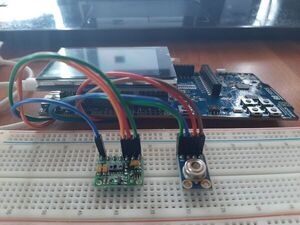
Heart beat, SPO2 and body temperature remote patient monitor
"Measuring the body vitals are not hard but keep track of them very difficult. This device can measure body vitals easily. Introduction Measuring the body vitals are not hard but keep track of them very difficult. This wearable is capable of measuring Heart beat, SPO2 and body temperature then post those data to smart phone (via BLE) to keep track of them. Using the phone we can see the historical data easily. Using nRF5340DK, touch display, MLX90614 body temperature sensor, MAX30100 pulse oximeter sensor and li-po battery, I am planning build an unique wearable solution." [...]

Flower Monitoring using Raspberry Pi & Arduino
"Simple project that uses a Raspberry Pi 3 Model B and an Arduino in order to read data from sensors and display it on a flask website. Imagine what life would be like without our inanimate green friends.. Flowers, beyond the fact that they are excellent items for decoration of various environments, are actual stress reducers and nature maintainers ( producing oxygen through photosynthesis). We all know how busy the modern life of a programmer can get, especially with the chaotic schedules the pandemic times brought upon us, therefore we thought of automating the process of checking how 'healthy' a plant is at the current moment of time.This small project is all about monitoring a flower using a soil moisture sensor and a DHT 11 temperature & humidity sensor. A buzzer is also included since 'singing' to flowers is scientifically proven to accelerate their growth. Once started, a Python server runs continuously on the Raspberry Pi 3 that hosts a website on which an user can see the parameters of the followed sensors." [...]
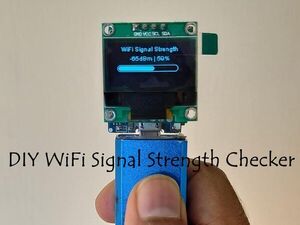
WiFi Signal Strength Scanner Monitor or Checker
"Easily check for WiFi drop out points, WiFi dead zones using this ultra portable device. Who likes a weak WiFi signal ? We can extend or improve our office or home WiFi signal using Mesh Systems or Extenders. But the extenders need to be placed at precise spots for optimum performance. You can use the device shown in this video to obtain the WiFi signal's strength at various points in your place to help you to identify the weak areas. Its a DIY WiFi signal strength checker so its fun." [...]
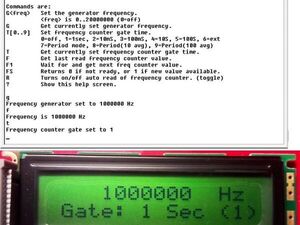
Frequency Generator and Frequency Counter for Pro Micro
"Libraries to implement a variable frequency generator and frequency counter for Pro Micro and Leonardo Overview Many times it is necessary to produce a programmable frequency output or implement a frequency counter for various uses. This project implements either or both of these functional blocks using only a low cost (≈$5-$17) Pro Micro (Sparkfun DEV-12640 or equivalent clone) module with an ATMega32U4 processor chip and software implemented using the Arduino IDE compiler and environment. These functional blocks can be used separately or together in a larger application or as a stand alone device. Since they are independent functions they will be covered separately. As part of this project a common main module is also included that can be used to set up the frequency generator or read the frequency from the frequency counter. This may be done via a serial port or alternatively, with 4 push button switches and an LCD display to use these functions as a stand alone device." [...]

A No-Cost Solution To Add WiFi To A Raspbery Pi Pico
"Introduction The Raspberry Pi Pico is a great little device. It has excellent capabilities, is low cost, has a well-thought-out SDK, and exceptional documentation but is missing just one thing – network connectivity. Several RP2040 based MCUs, are either currently on the market or are soon to be released. However, compared to the price of a Pico, these devices are rather costly. In addition, none of these solutions include hardwired Ethernet connectivity. This article will show you how to add network capabilities to your Pico cost-effectively using an existing network-capable Raspberry Pi." [...]

Morsibug: The Morse Machine
"Morsibug is an educational scientific project that aims to practice and learn Morse code. Introduction Morsibug is an educational scientific project that aims to practice and learn Morse code so that students (or anyone) can improve some mental skills like abstract calculations and mental agility while playing. The project uses two ESP8266 microcontrollers to communicate 2 boards (the Morsibugs) visually and audibly. Each of the two Morsibug will play the role of Morse transmitters/receivers at the same time, allowing a bidirectional connection between them. To communicate the Morsibugs without the need to be in the same space, the code uses WiFi and the MQTT protocol to establish bidirectional communication. A couple of finished Morsibug devices Required components ESP8266: any WiFi-enabled microcontroller compatible with the Arduino framework can be used for this project." [...]

Resettable E-Fuse
"A simple, cheap short circuit protector, controllable either manually or using a microcontroller. There are many E-fuses available both precises ones, used in industrial or critical situations, and [cheap] maker-friendly ones which despite doing their job, but are not suitable for protection of e.g. a $10k device. still, they are a perfect choice for simple, DIY projects. The pros: Instead of relays, it uses semiconductors. a suitable N-MOS with proper heat-sinking would last much more than mechanical solutions." [...]
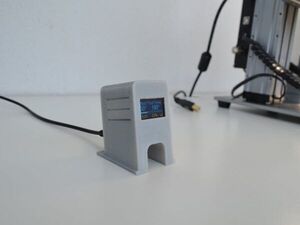
3D Printer Monitor using Wemos D1 Mini
"Monitor your 3D printer over a wifi connection. This is a Wemos D1 Mini and a 128x64 OLED combined together to display the status from your Introduction to OLED Monitor This app was developed and published by David Payne (also know as Qrome) in his GitHub repositoryfor all Makers who want to use it. In addition, he not only published the code, but added the printing files in Thingiversewhere you can easily download them. If you’re a 3D printing freak like us and you love messing around with electronics, you’re in luck. Keep reading this article to the end and you will find out how to do it very easily. And of course, do not forget to leave us your comments at the end of it." [...]
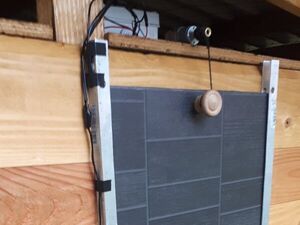
Automatic Solar Powered Chicken Door
"How to create and program a door that open and close at sunrise and sunset, powered by solar panel. I wanted to build something with an arduino since I have received and completed an "arduino starter kit". Therefore, this project is my first attempt at building something with an arduino (and electronics) and I have done a lot of mistakes along the way. This is far from being perfect and I can't guaranty it will work out if you try this yourself. I have written down all the mistakes I have done so you could avoid them. English is not my native language, sorry for potential grammatical or syntactic errors." [...]
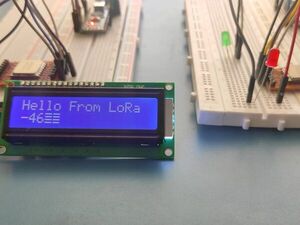
How To Use Lora With Arduino
"Basic Interface Of Lora With Arduino Today iam going to show you how to Interface LoRa Module (rfm95) With Arduino. this is a simple project does not require high knowledge about arduino and electronics this is an intermediate level project, so its kind of okay to you. I tried my best to document this project to you, to look simple. so you can also make this project as I do, if you appreciate my work, a sub to my youtube channelwill make me happy and keeps me motivated so I can make new projects for you in the near future, so with out further ado lets get started........" [...]
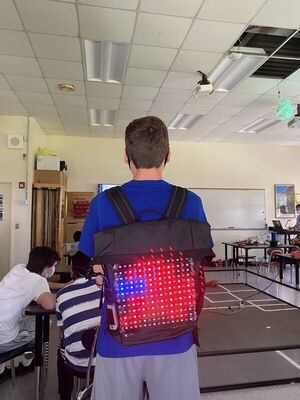
Among Us Backpack
"A neo-pixel displaying the among us character which I then attached to a backpack. Goal/ Requirements While making the Among Us backpack there were a couple goals that had to be met, including: It had to be light enough for me to carry it on my back It had to be able to fit on my backpack It had to be bright enough to be seen even in the day It had to have a power source that was both portable and able to produce enough volts and amps to meet the second requirement (about 5V 1A) The project had to be able to run for long amounts of time without overheating The project had to display the lights in a way so that it was easy to recognize it as the among us character. Before starting the project in person, I originally used tinkercad in order to make my first prototypes. Initially I made the project on an 8 by 8 grid, however this broke my last requirement as the character was very short and distorted. I also made a blue background which made it even harder to see. I compromised for this by making my second draft without the background and on a 12 by 12 grid, however after measuring the bag I planned on using I realized this broke my second requirement as the grid was too fat to fit on my bag." [...]
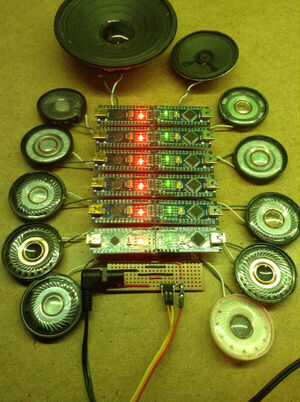
Arduino Tone One Year On!
"One year ago I posted the following two articles: Arduino Tone Generator Arduino Note Generator Shortly followed by an associated video on YouTube and so the Simple DIY Electronic Music Projects blog was born! They were then followed by the Arduino MIDI Tone Module and many others since. So in honour of my one-year anniversary, after more than 180 posts, including the launch of the Lo-Fi Orchestra, I wanted to return to those “tone” roots and do something slightly different. Here are twelve Arduino Nanos, each with a speaker and armed with nothing more than the MIDI library and the tone() function bringing you my favourite selection of music from the whole of the Star Wars saga – the fanfare from the last scenes of Star Wars Episode IV A New Hope. " [...]

PicoVGA - VGA/TV display on Raspberry Pico
"The PicoVGA library allows output from the Raspberry Pico to a VGA monitor or PAL/NTSC TV, with a focus on ease of use in technical and gaming applications. It provides 4 graphic overlay layers with transparency, nearly 30 frame buffer formats that can be freely combined with each other, making do with limited RAM memory size. The limitation of output to 8 bits also contributes to RAM saving. The RP2040 processor contains 264 KB of RAM. This is not much for higher resolution image output and therefore RAM needs to be very sparing. In technical practice and for retro games (the processor does not have the power for more advanced games), 8-bit graphics output in R3G3B2 format (i.e." [...]
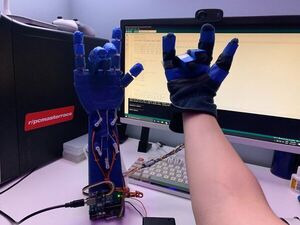
DIY Glove Controlled Robotic Hand
"Control a servo motor hand with the power of a glove and DIY flex sensors! This project uses budget items and DIY parts to create a fully functional robotic hand that can be controlled by a glove with flex sensors. It is an introduction project to the world of biomechanical engineering and design. Starting from the basic building blocks of foam and string, you will explore how physical mechanics are combined with electronic parts to form an attention grabbing project. " [...]
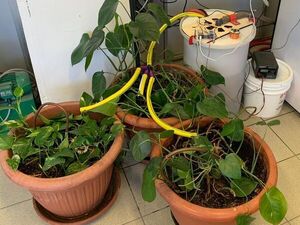
Smart Irrigation
"Automatic irrigation of 3 plants of Pothos, through the use of Wemos (ESP8266). The project aimed to wet the plants of Epipremnum aureum, commonly known as Pothos or Scindapsus aureus. These plants are found in the Prototyping laboratory of school "G.Vallauri" in Fossano and they are positioned near the ProtoMAX water jet machine. The purpose of this experience is precisely to water the plants by using the water used by the water jet machine. This appliance, during its processing, expels the water used outside; this water, after being suitably filtered, is conveyed into a bucket where there is a pump that will start to wet the 3 plants. In addition, the work required is to use the Blink software and Telegram to be able to control and if necessary also manually operate the system and the detectic data." [...]
Secção Videos
Videos interessantes.
That's all Folks!



